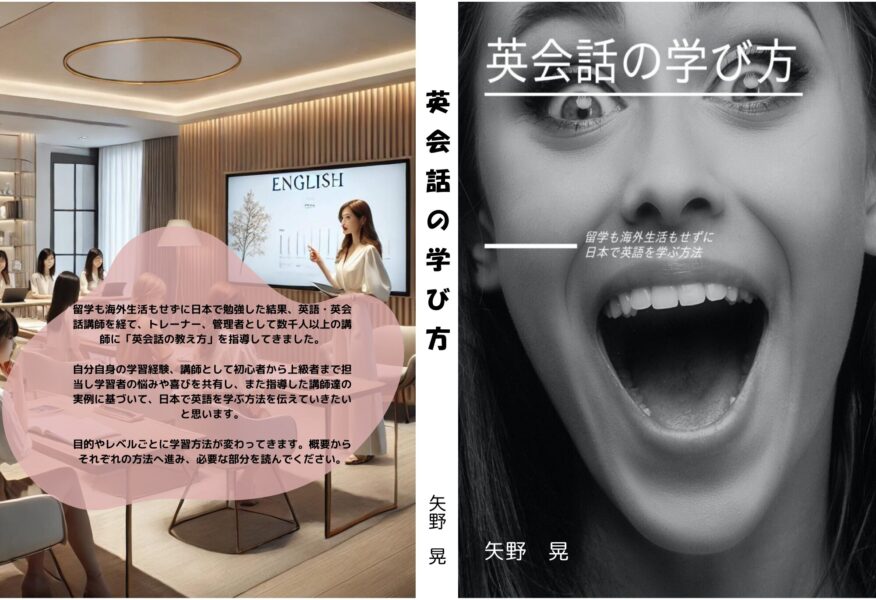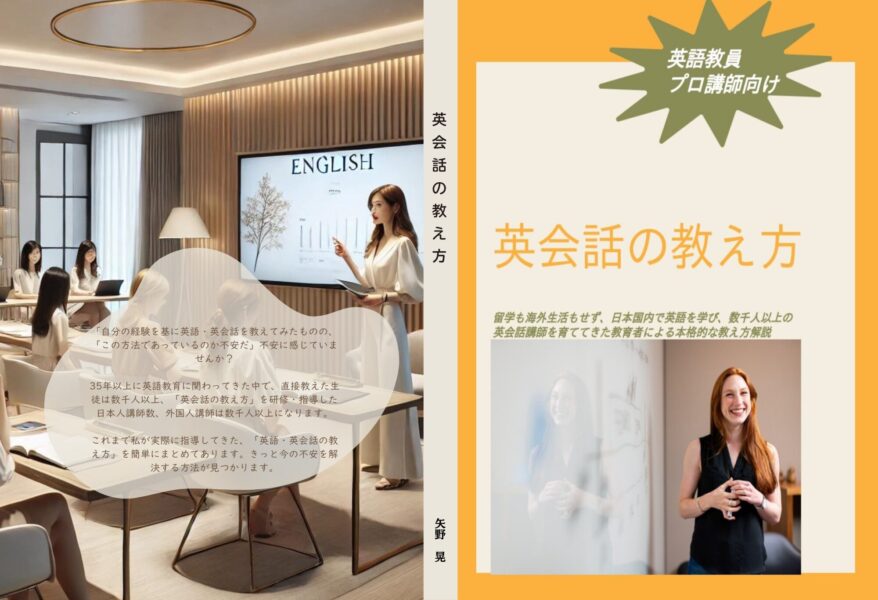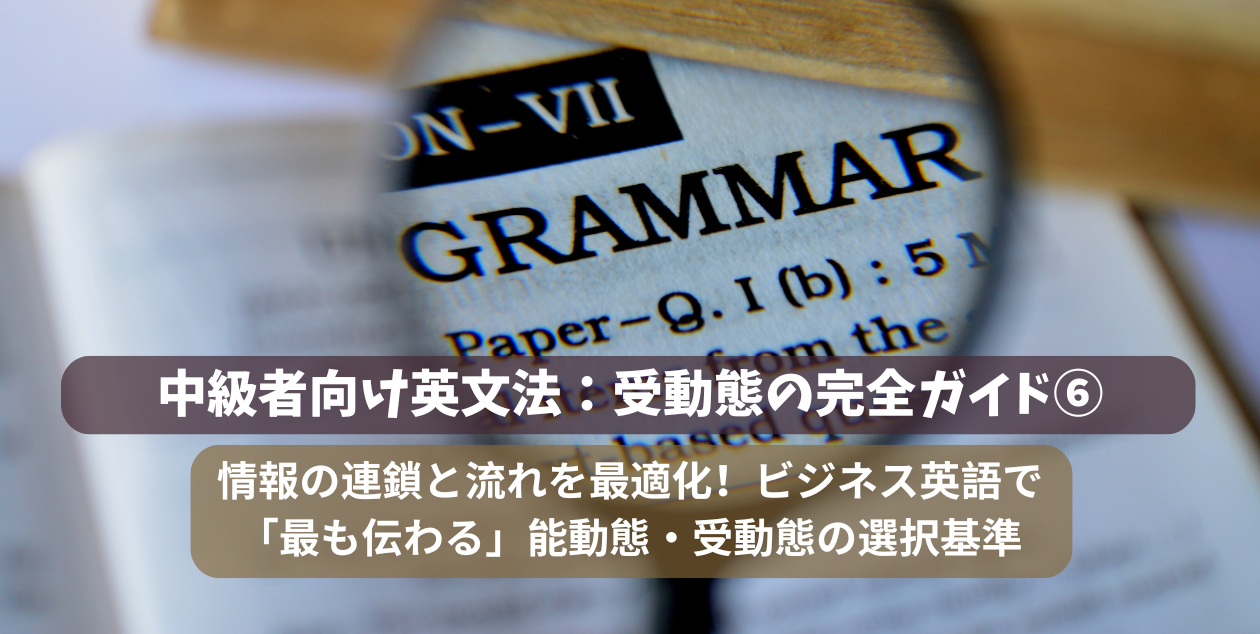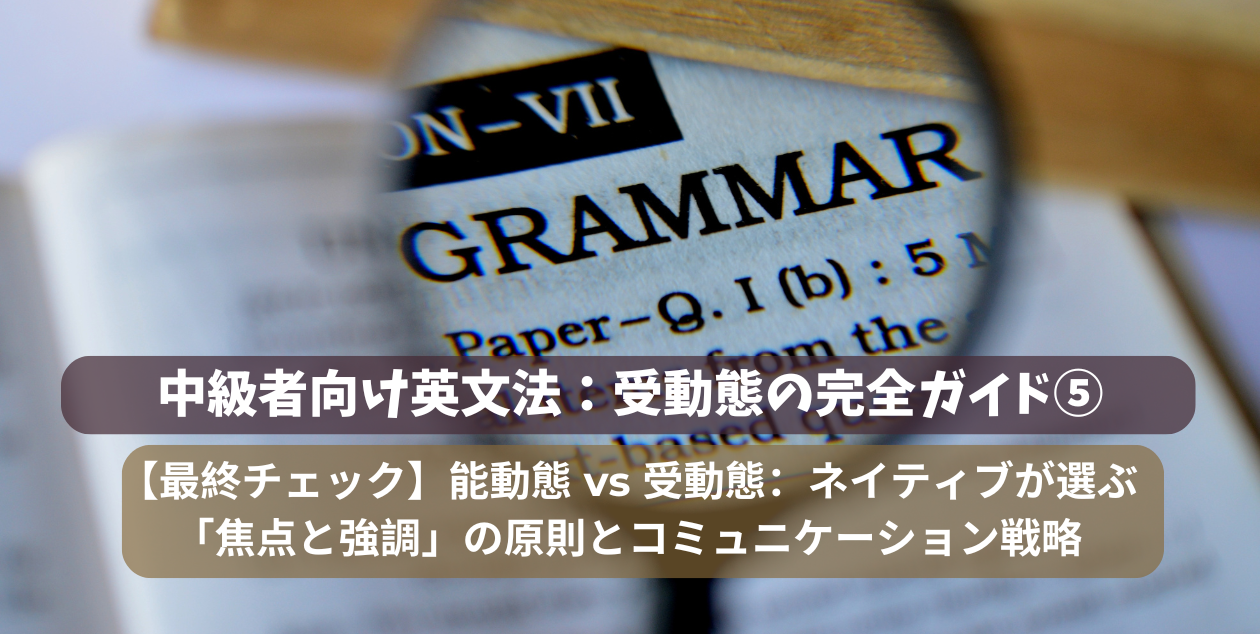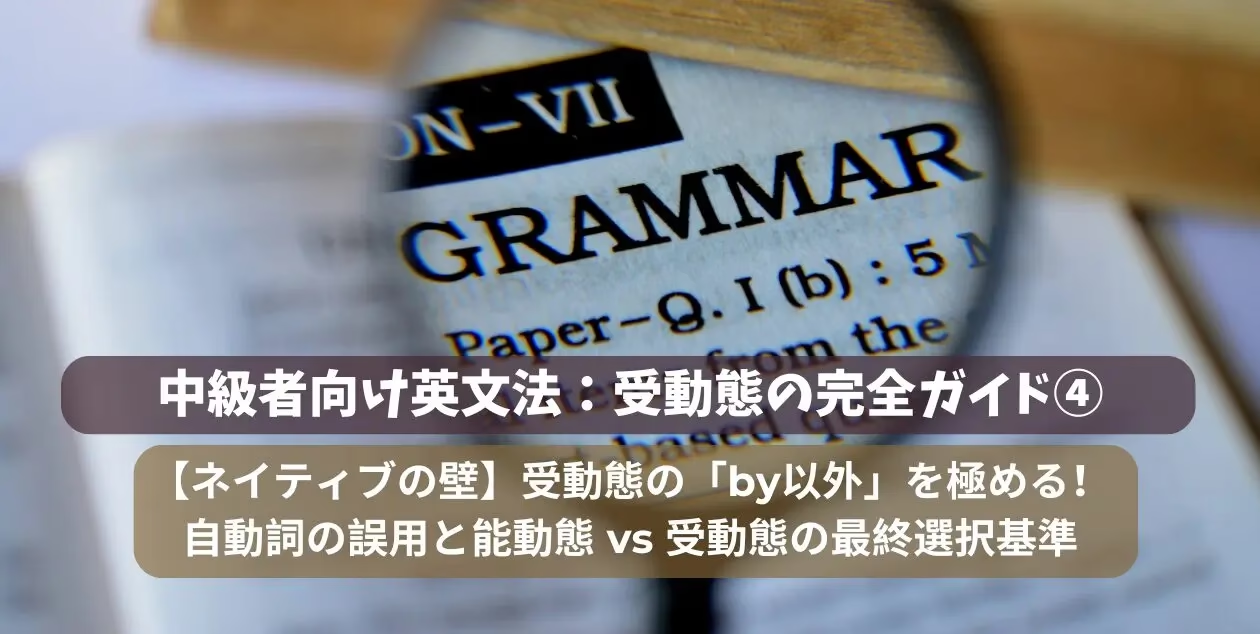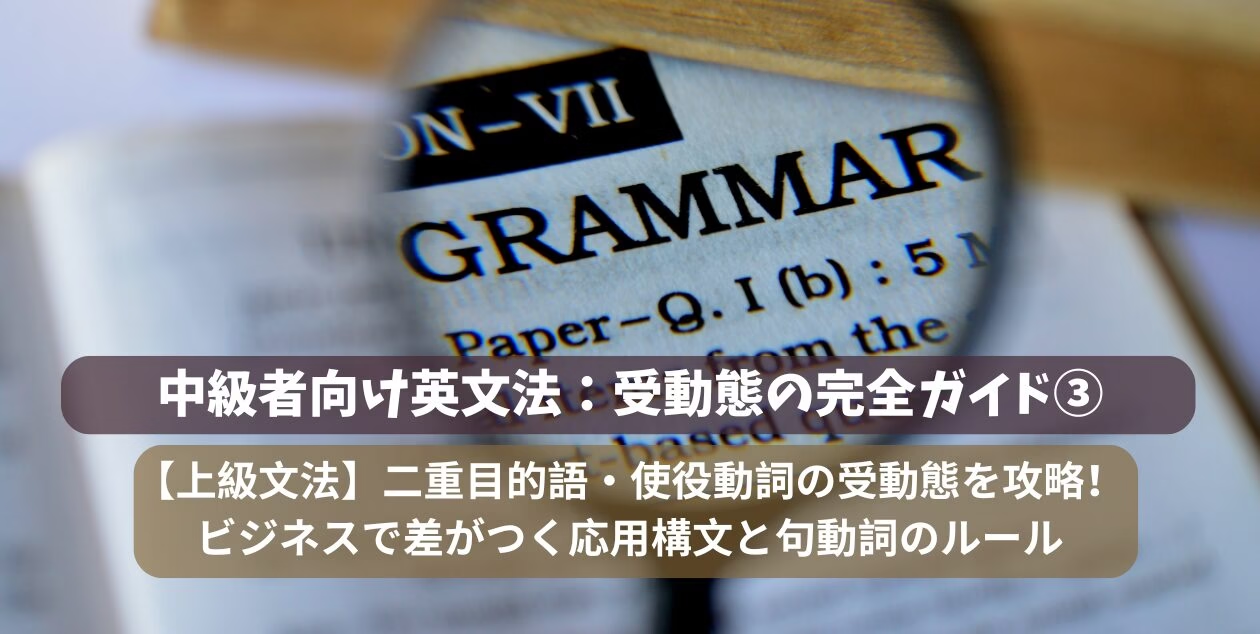グローバル化が進む医療現場では、英語でのコミュニケーション能力がますます重要になっています。外国人患者との対応、海外研修、国際学会への参加など、看護師として英語を使う機会は想像以上に多いものです。
しかし、「専門用語が多くて難しそう」「現場で実際にどう使えばいいかわからない」と感じている方もいるのではないでしょうか? 医療現場特有の英語表現は、一般的な英会話とは異なるため、体系的に学ぶことが不可欠です。
本記事では、看護師の1日の業務の流れに沿って、実践的な英語表現を徹底解説します。出勤から退勤まで、現場で本当に役立つ重要なフレーズを、発音記号、詳しい解説、例文とともに体系的に学ぶことができます。この記事を通して、外国人患者さんにも自信を持って接し、グローバルな医療現場で活躍するための第一歩を踏み出しましょう。
出勤・準備に関する英語表現

基本的な出勤準備
看護師の1日は早朝から始まります。まずは出勤から準備までの基本的な英語表現を学びましょう。
Arrive at hospital
- 発音記号: /əˈraɪv æt ˈhɒspɪtl/
- 意味: 病院に到着する
- 解説: 勤務開始前に余裕をもって到着し、身支度や状況確認の時間を取ることを表します
- 例文: She arrived at the hospital at 7:30 AM.
- 和訳: 彼女は午前7時30分に病院へ到着した。
Greet colleagues
- 発音記号: /ɡriːt ˈkɒliːɡz/
- 意味: 同僚に挨拶をする
- 解説: 温かい挨拶でその日のコミュニケーションを始める重要な行為です
- 例文: She greeted her colleagues before getting ready for her shift.
- 和訳: 彼女は勤務前に同僚に挨拶した。
Clock in
- 発音記号: /klɑːk ɪn/
- 意味: 出勤時間を記録する
- 解説: タイムカードまたは電子システムで勤務開始を記録します
- 例文: The nurse clocked in at 7:45 AM.
- 和訳: 看護師は午前7時45分に出勤打刻した。
身支度に関する表現
Change into scrubs
- 発音記号: /tʃeɪndʒ ˈɪntuː skrʌbz/
- 意味: スクラブに着替える
- 解説: ロッカールームで清潔な制服に着替える作業を指します
- 例文: She changed into scrubs before starting her shift.
- 和訳: 彼女は勤務開始前にスクラブに着替えた。
Store personal belongings
- 発音記号: /stɔːr ˈpɜːrsənl bɪˈlɒŋɪŋz/
- 意味: 私物をしまう
- 解説: ロッカーに貴重品や私物を安全に収納することを表します
- 例文: She stored her bag and phone in the locker.
- 和訳: 彼女は自分のカバンと携帯をロッカーにしまった。
Wash hands and sanitize
- 発音記号: /wɑːʃ hændz ənd ˈsænɪtaɪz/
- 意味: 手を洗い消毒する
- 解説: 感染予防のため病棟に入る前に必ず行う手指衛生を表します
- 例文: She washed her hands and sanitized before entering the ward.
- 和訳: 彼女は病棟に入る前に手を洗い消毒した。
朝の申し送り・患者ケアの英語表現

申し送りと情報確認
Attend handover/receive shift report
- 発音記号: /hændˈoʊvər/
- 意味: 申し送りを受ける
- 解説: 前勤務者から患者の経過や注意点を詳細に引き継ぐ重要なプロセスです
- 例文: The nurse attended the handover to learn about the patients’ overnight status.
- 和訳: 看護師は患者の夜間状態を把握するために申し送りに参加した。
Check patient charts
- 発音記号: /tʃek ˈpeɪʃnt tʃɑːrts/
- 意味: 患者カルテを確認する
- 解説: 新しい医師の指示や検査結果をチェックする作業を指します
- 例文: She checked the patient charts to review the medication orders.
- 和訳: 彼女は投薬指示を確認するために患者のカルテを見た。
物品準備と患者訪問
Organize supplies & equipment
- 発音記号: /ˈɔːrɡənaɪz səˈplaɪz ənd ɪˈkwɪpmənt/
- 意味: 備品・器具を整える
- 解説: 注射器や手袋等、必要な物品をワゴンに用意することを表します
- 例文: She organized the necessary supplies before visiting patients.
- 和訳: 彼女は患者のもとへ行く前に必要物品を準備した。
Quick patient rounds
- 発音記号: /kwɪk ˈpeɪʃnt raʊndz/
- 意味: 患者への朝の挨拶・安否確認
- 解説: 全患者の表情や体調を簡単に観察し声をかける業務です
- 例文: She did a quick round to greet all her patients.
- 和訳: 彼女は全患者に朝の挨拶をした。
バイタルサインと基本ケア
Measure vital signs
- 発音記号: /ˈmɛʒər ˈvaɪtəl saɪnz/
- 意味: バイタルサインを測定する
- 解説: 体温や脈拍、血圧、呼吸などを記録する基本的な看護業務です
- 例文: The nurse measured the vital signs of all patients.
- 和訳: 看護師は全患者のバイタルを測定した。
Assist with morning hygiene
- 発音記号: /əˈsɪst wɪð ˈmɔːrnɪŋ haɪˈdʒin/
- 意味: 朝の清拭や口腔ケア介助
- 解説: 患者の顔拭き、歯磨きや入れ歯の清掃を手伝う業務を指します
- 例文: The nurse assisted the patient with morning hygiene.
- 和訳: 看護師は患者の朝の清拭を手伝った。
Help with changing diapers
- 発音記号: /hɛlp wɪð ˈtʃeɪndʒɪŋ ˈdaɪpərz/
- 意味: おむつ交換介助
- 解説: 自力でトイレができない方の排泄ケアを表します
- 例文: She helped change the elderly patient’s diaper.
- 和訳: 彼女は高齢患者のオムツを替えた。
医療処置・投薬に関する英語表現
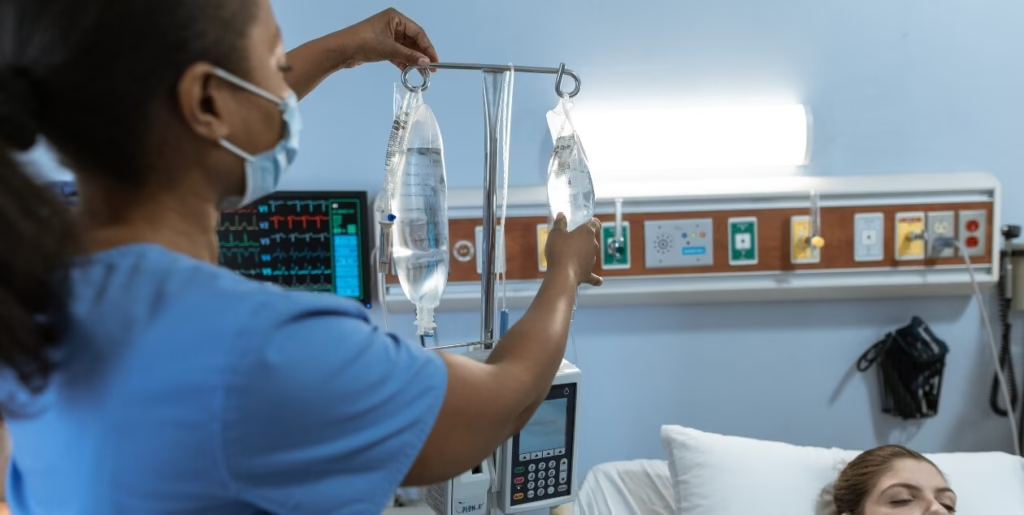
投薬業務
Administer medication
- 発音記号: /ədˈmɪnɪstər ˌmɛdɪˈkeɪʃən/
- 意味: 薬を投与する
- 解説: 内服・注射・点滴など医師指示に基づき薬を投与することを表します
- 例文: She administered medication to patients after breakfast.
- 和訳: 彼女は朝食後に患者に薬を投与した。
点滴・処置管理
Set up and monitor IV drip
- 発音記号: /sɛt ʌp ənd ˈmɒnɪtə aɪ viː drɪp/
- 意味: 点滴の設置・管理
- 解説: 点滴針の挿入と流量調整、異常がないか観察する業務です
- 例文: She set up an IV drip for the patient.
- 和訳: 彼女は患者に点滴をセットした。
Change dressings
- 発音記号: /tʃeɪndʒ ˈdrɛsɪŋz/
- 意味: 創傷のドレッシング交換
- 解説: 感染管理に細心の注意を払い包帯やガーゼを取り替える処置です
- 例文: The nurse changed the wound dressings carefully.
- 和訳: 看護師は傷のガーゼを丁寧に交換した。
排泄介助
Help with toileting
- 発音記号: /hɛlp wɪð ˈtɔɪlətɪŋ/
- 意味: トイレ誘導・排泄介助
- 解説: 必要に応じてトイレまで付き添い・支援する業務を指します
- 例文: She helped the elderly patient with toileting.
- 和訳: 彼女は高齢の患者の排泄介助をした。
医師との連携・患者搬送の英語表現

医師との協働
Assist the doctor during rounds
- 発音記号: /əˈsɪst ðə ˈdɒktər ˈdʊrɪŋ raʊndz/
- 意味: 医師回診の補助
- 解説: バイタルや症状報告、カルテ確認、指示受けなどの医師サポート業務です
- 例文: The nurse assisted the doctor during morning rounds.
- 和訳: 看護師は朝の回診で医師の補助をした。
患者搬送業務
Transport patients for tests
- 発音記号: /ˈtrænspɔːrt ˈpeɪʃənts fɔːr tɛsts/
- 意味: 検査のための患者搬送
- 解説: 車椅子やストレッチャーで放射線科・検査室へ安全に誘導する業務です
- 例文: The nurse transported a patient to the radiology department.
- 和訳: 看護師は患者を放射線科に搬送した。
食事・記録・家族対応の英語表現

食事介助
Help patients eat
- 発音記号: /hɛlp ˈpeɪʃənts iːt/
- 意味: 食事介助
- 解説: 摂食困難な方にスプーンやストローを使って食事を支援することを表します
- 例文: She helped the stroke patient eat lunch.
- 和訳: 彼女は脳卒中の患者の昼食を手伝った。
Monitor food and fluid intake
- 発音記号: /ˈmɒnɪtə fuːd ənd ˈfluːɪd ˈɪnteɪk/
- 意味: 食事・水分摂取量の確認
- 解説: 必要があれば摂取量をグラムやml単位で記録する業務です
- 例文: She monitored and recorded the patient’s food and fluid intake.
- 和訳: 彼女は患者の食事と水分摂取量を記録した。
記録業務
Chart care notes
- 発音記号: /tʃɑːrt keər noʊts/
- 意味: ケア内容の記録
- 解説: 電子カルテ等へバイタル・処置内容・患者への声かけ反応等を記載することです
- 例文: The nurse charted notes about each patient’s condition.
- 和訳: 看護師は各患者の状態について記録を残した。
午後のケア・リハビリ支援の英語表現
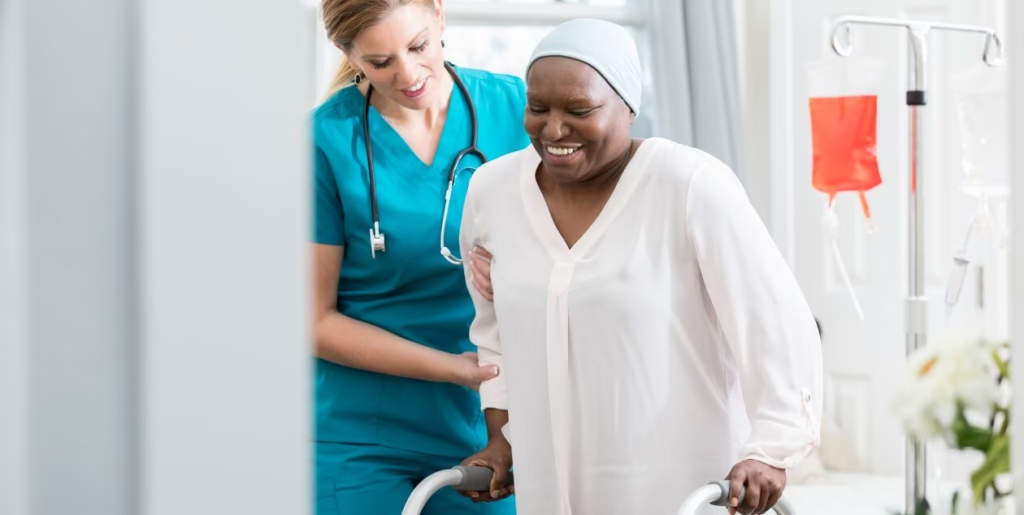
体位変換とリハビリ
Reposition bedridden patients
- 発音記号: /ˌriːpəˈzɪʃən ˈbɛdrɪdn ˈpeɪʃənts/
- 意味: 体位変換
- 解説: 2時間ごとの姿勢変更やクッション調整など褥瘡防止ケアを表します
- 例文: She repositioned the patient every two hours.
- 和訳: 彼女は2時間ごとに患者の体位を変えた。
Assist with rehabilitation
- 発音記号: /əˈsɪst wɪð ˌriːhəˌbɪlɪˈteɪʃən/
- 意味: リハビリ介助
- 解説: 理学療法士の指示のもと、歩行練習や関節運動の補助を行うことです
- 例文: She assisted with the patient’s rehabilitation exercises.
- 和訳: 彼女は患者のリハビリ補助をした。
家族対応・コール対応
Talk to family members
- 発音記号: /tɔːk tuː ˈfæmɪli ˈmɛmbərz/
- 意味: 患者家族との面談・対応
- 解説: 症状やケア内容の説明、退院支援等の家族コミュニケーションです
- 例文: The nurse talked to the family members about discharge planning.
- 和訳: 看護師は退院について家族と話をした。
Respond to call bells
- 発音記号: /rɪˈspɒnd tə kɔːl bɛlz/
- 意味: ナースコール対応
- 解説: 患者の求めに応じてベッドサイドへ駆けつける業務を指します
- 例文: She promptly responded to patients’ call bells.
- 和訳: 彼女はすぐに患者のナースコールに対応した。
退勤準備・引き継ぎの英語表現

引き継ぎ業務
Give a handover report
- 発音記号: /ɡɪv ə ˈhændoʊvər rɪˈpɔːrt/
- 意味: 次の勤務者への申し送り
- 解説: 夜勤者へ詳細な患者状況や注意事項を連絡する重要な業務です
- 例文: She gave a handover report before ending her shift.
- 和訳: 彼女は勤務終了前に申し送りを行った。
環境整備
Restock supplies
- 発音記号: /riːˈstɒk səˈplaɪz/
- 意味: 備品の補充
- 解説: 注射器・ガーゼなど次シフトのため物品整理・補充を行うことです
- 例文: She restocked the nursing station before leaving.
- 和訳: 彼女は退勤前にナースステーションの物品を補充した。
Dispose of medical waste
- 発音記号: /dɪˈspoʊz əv ˈmɛdɪkəl weɪst/
- 意味: 医療廃棄物の処理
- 解説: 使い捨て手袋、注射器等の感染性ゴミの適切処理を表します
- 例文: She disposed of all medical waste properly.
- 和訳: 彼女はすべての医療廃棄物を適切に処理した。
Final safety checks
- 発音記号: /ˈfaɪnl ˈseɪfti tʃeks/
- 意味: 最終安全確認
- 解説: 点滴やベッド柵の確認、転倒予防策の再確認などを行うことです
- 例文: She did a final safety check before her shift ended.
- 和訳: 彼女は勤務終了前に最終安全確認をした。
退勤手続き
Change out of scrubs
- 発音記号: /tʃeɪndʒ ˈaʊt əv skrʌbz/
- 意味: スクラブから私服に着替える
- 解説: ロッカー室で私服に着替え、忘れ物がないか確認することを表します
- 例文: She changed out of scrubs before leaving the hospital.
- 和訳: 彼女は退勤前にスクラブから着替えた。
Clock out
- 発音記号: /klɑːk aʊt/
- 意味: 退勤打刻をする
- 解説: タイムカード/勤怠システムで勤務終了を記録することです
- 例文: The nurse clocked out at 5:30 PM.
- 和訳: 看護師は午後5時30分に退勤打刻した。
Say good-bye to colleagues
- 発音記号: /seɪ ɡʊdˈbaɪ tə ˈkɒliːɡz/
- 意味: 同僚に別れの挨拶をする
- 解説: 一日の労をねぎらい合い、笑顔で挨拶して帰宅することを表します
- 例文: She said good-bye to her colleagues at the end of the day.
- 和訳: 彼女は一日の終わりに同僚に別れの挨拶をした。
実践的な会話例

看護師同士の会話例
ナースステーションでの休憩中の会話
Nurse Emily:
Good morning, Jason. What time did you clock in today?
Nurse Jason:
I clocked in at 7:45 AM, same as usual. Then I went to the locker room to change into scrubs.
Nurse Emily:
Did you have time to attend handover?
Nurse Jason:
Yes, I attended the handover to catch up on what happened during the night shift. I also checked the patient charts and wrote down a few notes from the doctor’s orders.
Nurse Emily:
Same here. I started my morning by measuring vital signs for all the patients in Room 3.
Nurse Jason:
After that, I administered medication to Mr. Tanaka. His blood pressure was a bit high, so I kept monitoring him closely.
Nurse Emily:
I heard he had a wound dressing that needed to be changed.
Nurse Jason:
Yes, I changed the dressings and made sure everything was sterile. I also had to help with toileting for Mrs. Yamada—she was feeling quite weak this morning.
Nurse Emily:
I see. Did you assist the doctor during rounds afterward?
Nurse Jason:
Yes, I walked with Dr. Sato during the morning rounds and reported the patients’ updates. After that, I transported a patient for tests—a head CT for Mr. Kubo.
Nurse Emily:
Lunch time was busy too, right?
Nurse Jason:
Definitely. I had to help a patient eat—she was recovering from a stroke. After lunch, I charted care notes about her condition and response to treatment.
Nurse Emily:
Did you have any interaction with families?
Nurse Jason:
Yes, I talked to the family members of Mr. Ito. They were asking about his discharge plan, so I explained the next steps.
Nurse Emily:
Sounds like a busy shift! What about the end-of-shift routines?
Nurse Jason:
I did a round to reposition the bedridden patients, then I gave a handover report to the evening staff. I also disposed of medical waste and restocked supplies.
Nurse Emily:
When did you finish?
Nurse Jason:
I changed out of scrubs and clocked out at 5:30 PM. It was a long but productive day.
エミリー看護師:
おはよう、ジェイソン。今日は何時に出勤打刻(clock in)したの?
ジェイソン看護師:
午前7時45分に出勤打刻したよ。いつも通りね。それからロッカー室に行ってスクラブに着替えた(change into scrubs)んだ。
エミリー看護師:
申し送り(attend handover)には間に合った?
ジェイソン看護師:
うん、申し送りに参加して、夜勤中に何があったかを把握したよ。それからカルテを確認(check patient charts)して、医師の指示をいくつかメモしたんだ。
エミリー看護師:
こっちも同じよ。朝一番に全員のバイタル測定(measure vital signs)を行ったわ。
ジェイソン看護師:
それが終わってから、田中さんに*薬を投与(administer medication)したよ。血圧がちょっと高かったから、注意して観察してた。
エミリー看護師:
彼、ガーゼ交換(change dressings)も必要だったんじゃない?
ジェイソン看護師:
うん、きちんとガーゼ交換もしたよ。清潔操作には気をつけた。それから、山田さんの排泄介助(help with toileting)もした。今朝は少しふらついてたからね。
エミリー看護師:
なるほどね。回診で医師の補助(assist the doctor during rounds)には入った?
ジェイソン看護師:
うん、佐藤先生の回診の補助をして、患者の状態を報告したよ。その後、久保さんを放射線科への検査搬送(transport patients for tests)に連れて行った。CT検査のためにね。
エミリー看護師:
昼食の時間も忙しかったでしょ?
ジェイソン看護師:
間違いないよ。脳梗塞後で手が使いにくい患者さんの食事介助(help a patient eat)をしたんだ。昼食後は、ケア内容をカルテに記録(chart care notes)しておいた。
エミリー看護師:
ご家族との対応はあった?
ジェイソン看護師:
うん、伊藤さんのご家族と退院について話した(talk to family members)よ。退院計画について詳しく説明したんだ。
エミリー看護師:
忙しいシフトだったね!夕方はどうだった?
ジェイソン看護師:
寝たきりの患者の体位変換(reposition bedridden patients)をして、その後夜勤のスタッフに申し送り(give a handover report)を済ませて、医療廃棄物も処理(dispose of medical waste)したよ。その後物品の補充も済ませたよ。
エミリー看護師:
おつかれさま。何時に終わったの?
ジェイソン看護師:
スクラブから着替えて(change out of scrubs)、午後5時30分に退勤打刻(clock out)したよ。長い一日だったけど、やりがいがあったね。
医師と看護師の会話例
朝の病棟回診中の会話
Dr. Smith:
Good morning, Laura. Have you checked the patient charts for Mr. Davis?
Nurse Laura:
Yes, I checked the patient charts earlier and noted that his blood pressure was slightly elevated.
Dr. Smith:
Did you measure his vital signs already?
Nurse Laura:
Yes, I measured the vital signs for all patients in Room 5. Mr. Davis’s BP was 150/95.
Dr. Smith:
Thanks. Did he receive his medication?
Nurse Laura:
Yes, I administered medication to him right after breakfast.
Dr. Smith:
Excellent. How’s the wound on his leg?
Nurse Laura:
I also changed dressings this morning. There’s no sign of infection, but I’ll continue to monitor it.
Dr. Smith:
Did he have any issues with mobility or toileting?
Nurse Laura:
He needed a bit of support, so I helped with toileting after his medication.
Dr. Smith:
Alright. Could you transport him for tests if radiology calls?
Nurse Laura:
Of course. I already spoke with radiology, and I’ll transport the patient for tests once they’re ready.
Dr. Smith:
Also, please make sure to chart care notes about his wound and any complaints he mentions.
Nurse Laura:
Absolutely. I already began to chart care notes, and I’ll update them after our rounds.
Dr. Smith:
One more thing—Mr. Davis’s family asked about potential discharge dates. Could you talk to the family members later today?
Nurse Laura:
Yes, I can talk to the family members and explain the care plan and follow-up instructions.
Dr. Smith:
Great. After the rounds, please help the new nurse attend handover for the afternoon shift.
Nurse Laura:
Will do. I’ll also remind her to clock in and change into scrubs before entering the ward.
スミス医師:
おはよう、ローラ。デイビスさんのカルテは確認(check the patient charts)しましたか?
ローラ看護師:
はい、先ほどカルテを確認しました。彼の血圧がやや高めだったことをメモしています。
スミス医師:
バイタルサインの測定(measure vital signs)は済んでいますか?
ローラ看護師:
はい、病室5の全員についてバイタル測定を行いました。デイビスさんの血圧は150/95でした。
スミス医師:
ありがとうございます。薬はもう投与しましたか?
ローラ看護師:
はい、朝食後すぐに薬を投与(administer medication)しました。
スミス医師:
いいですね。足の傷の具合はどうでしたか?
ローラ看護師:
今朝ガーゼ交換(change dressings)も行いました。感染の兆候は見られませんが、今後も注意深く観察を続けます。
スミス医師:
排泄や移動に問題はありませんか?
ローラ看護師:
多少の介助が必要でしたので、薬を投与した後で排泄介助(help with toileting)を行いました。
スミス医師:
承知しました。もし放射線科から連絡が来たら、検査のために患者を搬送(transport patients for tests)してもらえますか?
ローラ看護師:
もちろんです。すでに放射線部門には連絡してあり、準備ができ次第搬送します。
スミス医師:
あと、傷の様子や本人が訴える症状をカルテに記録(chart care notes)してください。
ローラ看護師:
はい、すでに記録を始めています。回診後に最新情報を追記します。
スミス医師:
もうひとつ。デイビスさんの家族が退院の時期について確認していました。後でご家族に対応(talk to family members)してもらえますか?
ローラ看護師:
もちろんです。ご家族に話して、今後のケア計画や退院後の対応について説明します。
スミス医師:
助かります。それから、回診が終わったら新人ナースに次の勤務の申し送り(attend handover)への参加を勧めてください。
ローラ看護師:
お任せください。彼女には出勤打刻(clock in)を済ませてからスクラブに着替える(change into scrubs)ようにも伝えておきます。
“A Day in the Life of a Nurse“を読んでみましょう!

A Day in the Life of a Nurse
At 7:45 in the morning, Emily arrived at the hospital and clocked in. She greeted her colleagues with a smile and walked to the staff locker room. There, she changed into scrubs, carefully tying her hair back and making sure her ID badge was visible.
At 8:00 AM sharp, she went to the nurse station to attend handover. The night shift nurse shared updates about each patient’s condition, medication changes, and any overnight incidents. Emily listened attentively and took notes. After the briefing ended, she opened her tablet and checked the patient charts to review each patient’s vitals, diagnoses, and doctor’s orders.
As part of the morning routine, she then began rounding. She measured vital signs—temperature, pulse, blood pressure, and respiratory rate—for every patient in her care. One elderly patient had slightly low oxygen saturation, so she adjusted the nasal cannula and monitored closely.
After the rounds, around 9:00 AM, she returned to the station, prepared several medications according to the scheduled times, and went room to room to administer medication. She explained the purpose of each drug to her patients kindly and ensured that they safely ingested or received injections.
Later, in Room 302, she noticed that a post-op patient’s bandage was soaked. She quickly gathered sterile supplies and changed dressings carefully, following all infection control precautions. Right after, she responded to a nurse call from down the hall—one of her elderly patients needed to use the bathroom, so she assisted gently. It was part of her daily task to help with toileting for those who couldn’t manage on their own.
At 10:30 AM, Emily accompanied Dr. Sato on morning rounds. She knew every patient’s details and could assist the doctor during rounds by reporting changes in condition and updating the chart immediately. After the last room, radiology called. A patient needed a CT scan, so she helped transport the patient for tests, wheeling them down safely and making sure the paperwork was in order.
By noon, lunch trays arrived. Emily helped a stroke patient sit up and helped the patient eat, feeding gently and encouraging the patient to chew and swallow slowly. Afterward, back at the station, she took 15 minutes to chart care notes, documenting medications given, wound conditions, patient responses, and other observations.
In the early afternoon, Emily performed routine turning for a long-term bedbound patient. Every two hours, she made sure to reposition bedridden patients to prevent pressure injuries and maintain comfort. Around 2:30 PM, she received a phone call from a patient’s daughter. She arranged a meeting and went over the discharge plan in detail, using her experience to talk to family memberswith empathy and clarity.
As the afternoon wore on, Emily helped colleagues catch up, responded to additional patient calls, and began preparing for shift change. By 5:00 PM, she had updated all her notes and sat down with the evening staff to give a handover report, outlining everything they needed to know about each patient. Once the report was complete, she disposed of used materials, gloves, and tubing, taking time to dispose of medical waste according to hospital protocol.
Finally, her shift was over. She returned to the locker room, tired but satisfied, and changed out of scrubs into her street clothes. Then she clocked out at 5:30 PM, waved goodbye to her coworkers, and headed home—ready to do it all again tomorrow.
看護師の1日
朝7時45分に、エミリーは病院に到着し、出勤打刻(clocked in)を行った。彼女は同僚たちに笑顔で挨拶し、スタッフ用ロッカー室へ向かった。そこで彼女はスクラブに着替え(changed into scrubs)、髪をしっかりと結び、名札が見えるように整えた。
8時ちょうど、彼女はナースステーションに行き、申し送り(attend handover)に参加した。夜勤の看護師から、それぞれの患者の状態、投薬の変更、夜間に起きた出来事について共有された。エミリーは真剣に耳を傾け、メモを取った。その後、タブレットを開いて患者のカルテを確認(checked the patient charts)し、バイタルサインや診断名、医師の指示を確認した。
朝のルーチンとして、彼女は病室を回りながら、すべての患者のバイタルサインを測定(measured vital signs)した。体温、脈拍、血圧、呼吸数を記録し、高齢の患者の酸素濃度がやや低下しているのに気づくと、酸素投与を調整し観察を続けた。
9時頃にはナースステーションに戻り、医師のスケジュールに合わせて数種の内服薬や注射薬を準備し、患者の部屋を回りながら投薬(administered medication)を行った。それぞれの薬について説明し、誤嚥や誤投与がないよう慎重に処置を行った。
その後、術後の患者の足の包帯が染みているのに気づいたエミリーは、滅菌処置用具を揃え、慎重にガーゼ交換(changed dressings)を行った。そのすぐ後、廊下のナースコールが鳴り響く―高齢患者からの呼び出しだった。彼女はすぐに駆けつけ、丁寧に排泄介助(helped with toileting)を行った。
10時30分、エミリーは佐藤医師の回診に同行(assisted the doctor during rounds)した。彼女は各患者の状態を正確に報告し、医師の指示をその場で電子カルテに記録した。回診の後、放射線科から患者の呼び出しが入ったため、彼女は一人の患者をストレッチャーに乗せて検査のために移送(transported the patient for tests)した。検査依頼書と患者照合も忘れない。
正午には昼食が配膳され、エミリーは脳梗塞による片麻痺のある患者を支え、食事介助(helped the patient eat)を行った。スプーンを使い、ゆっくりと食べられるよう声かけをしながら支援した。
昼食後はナースステーションに戻り、その日のケア内容、バイタル、観察事項などを電子カルテに記録(charted care notes)した。患者が発した小さな違和感も漏らさず記載するのが、エミリーのモットーだった。
午後には、褥瘡予防のため、2時間おきに寝たきりの患者の体位変換(repositioned bedridden patients)を行った。彼女は体に無理のないよう慎重に姿勢を変え、クッションの位置を調整した。
2時過ぎ、ある患者の娘さんから「退院の話を詳しく聞きたい」と電話が入り、エミリーは直接面談を行った。退院後の生活や家庭内介護の注意点について、わかりやすく丁寧にご家族と話をした(talked to family members)。
午後5時近く、エミリーは業務終了の準備に入った。必要な情報を整理し、夜勤の担当者に申し送り(give a handover report)を行った。バイタルの変化や訴え、処置済み内容を詳細に伝えた。その後、昼に使用した注射針やガーゼ、手袋などの感染性物品を適切に処分(disposed of medical waste)した。
すべての業務が終わると、彼女はロッカー室に戻り、スクラブから着替え(changed out of scrubs)、身支度を整えてから退勤打刻(clocked out)を行った。時計を見ると、午後5時30分。今日もまた、多くの患者の小さな変化を見守った、充実した一日だった。
まとめ

本記事では、看護師の1日の業務の流れに沿って、現場で使える実践的な英語フレーズを網羅的にご紹介しました。出勤準備から、バイタル測定、投薬、医師との連携、そして退勤まで、具体的な場面を想定した表現を学ぶことで、英語でのコミュニケーションのイメージがより鮮明になったのではないでしょうか。
単に単語を覚えるだけでなく、業務の流れに沿ってフレーズを学習することで、知識が定着しやすくなります。また、豊富な会話例を通して、同僚や医師とのやりとりにおける英語の使い方を実践的に理解できたはずです。
英語でのコミュニケーションスキルは、患者さんとの信頼関係を築き、より質の高いケアを提供する上で強力な武器となります。この記事が、あなたの医療英語学習の一助となり、グローバルな医療現場で自信を持って活躍するための確かな土台を築くきっかけとなれば幸いです。
重要なのは、これらの表現を単に暗記するのではなく、実際の業務の流れの中で自然に使えるようになることです。発音記号を参考に正確な発音を身につけ、例文を通して使用場面をイメージしながら練習しましょう。
また、医療英語は専門性が高いため、継続的な学習が重要です。日々の業務の中で英語表現を意識的に使用し、同僚や医師とのコミュニケーションで実践することで、より自然で効果的な英語力を身につけることができます。
あなたの英語学習をさらに進めるために
- 実践練習: 今日から職場で1つでも英語表現を使ってみましょう
- 発音練習: 発音記号を参考に、正確な発音を身につけましょう
- 継続学習: 毎日5分間、医療英語の表現を復習する習慣を作りましょう
英語・英会話の基礎を学びたい方はこちらから! ↓

語彙力強化したい方はこちらから! ↓












